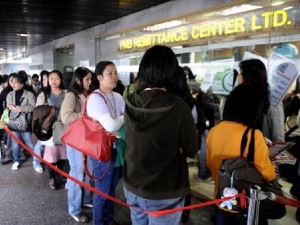Remittances hit all-time high in 2013

Filipino domestic helpers line up to send money at a remittance center in the central district of Hong Kong in this 2008 file photo. AFP/TED ALJIBE
Cash sent home by migrant workers, one of the main drivers of the country’s economic growth, rose to record levels last year despite the continued weakness of the global economy.
The Bangko Sentral ng Pilipinas (BSP) Monday reported that growth in remittances from overseas Filipino workers (OFWs) beat expectations in 2013, helping prop up consumer demand despite the high unemployment in the country.
“The solid growth of remittances from OFWs remains supportive of economic activity, with cash remittances accounting for 8.4 percent of the country’s gross domestic product in 2013,” the BSP said in a statement.
Cash remittances in December rose by 9.1 percent year-on-year to a record $2.2 billion. This brought the full-year figure to $22.8 billion—also the highest on record for any 12-month period—representing an increase of 6.4 percent from the previous year.
The expansion in 2013 was better than the 5-percent growth projected by the BSP at the start of the year.
These cash transfers from OFWs are the biggest source of foreign exchange for the country, ensuring the ample supply of dollars and other currencies that the economy needs for doing business with the rest of the world.
Remittances are also the major driver of domestic consumption, which makes up about two-thirds of GDP. The country’s economy as measured by GDP grew by 7.2 percent in 2013, beating government estimates and the second highest in Asia after China’s.
Late last year, BSP officials said remittances would grow more than expected as OFWs with families in areas affected by Supertyphoon “Yolanda” send more money to finance the reconstruction of homes.
In its statement, the BSP boasted that more than three-fourths or 77.1 percent of all remittances in December came from land-based workers with contracts of one year or more—an indication of the sustainability of the flows.
Cash transfers from sea-based workers rose at a faster rate of 7.9 percent versus 6 percent for land-based OFWs.
The major sources of remittances were the United States, Saudi Arabia, United Kingdom, United Arab Emirates, Singapore, Canada and Japan.
Apart from the sustained demand for Filipino labor, the BSP said the ever-expanding global presence of local banks and other financial institutions through the establishment of new offices or tie-ups with foreign partners has made it easier for OFWs to send money home safely.
As of end-December, commercial banks’ tie-ups, remittance centers and correspondent bank branches and representative offices in other countries stood at 4,740 locations.

